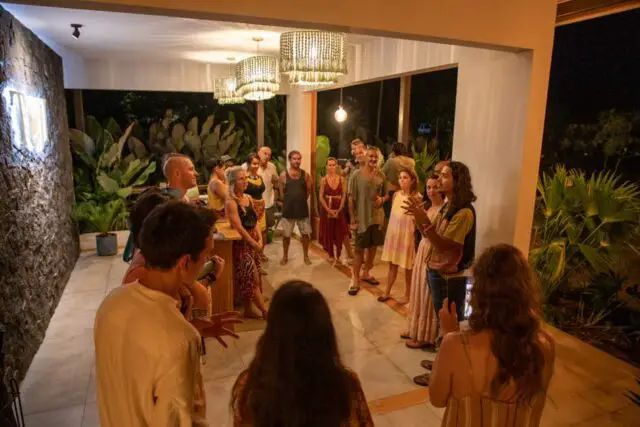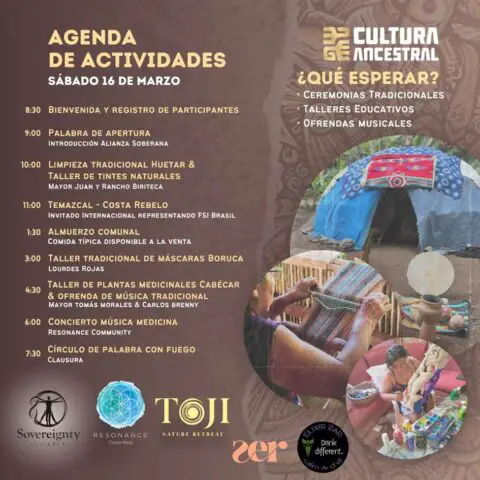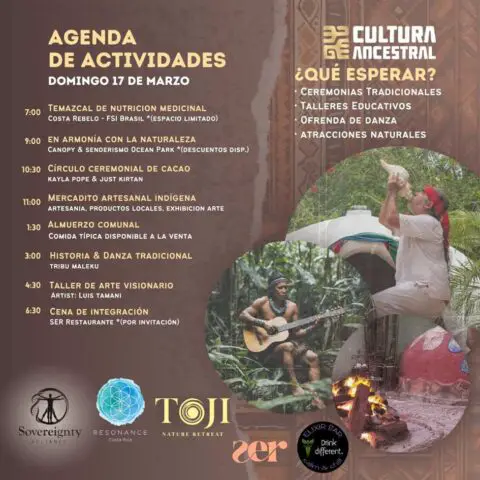On March 16th and 17th took place the first edition of CulturAncestral. It was organized by the Sovereignty Alliance Foundation, sponsored by Resonance and Toji and supported by Ser and the Elixir Bar. This cultural exchange event welcomed representatives of four indigenous communities in Esterillos Este and at the Resonance hub in Quebrada Amarilla. These two days represented an amazing opportunity for people interested by this subject to learn about various indigenous cultures.
Indigenous Populations Participating
The indigenous communities who participated in this event were the following: Boruca, Cabécar, Huetar, Maleku, alongside special guests Luis Tamani and Costa Rebelo, a member of the Fuego Sagrado de Itzachilatlan, a spiritual community which created their own spiritual path from different indigenous cultures. Originating mainly from Costa Rica, with some representation from Brazil, each community brought its unique culture and traditions, creating a medley of various activities, dishes, and traditional clothes that participants were delighted to discover.
Delve into the rich heritage of these four indigenous populations:
Boruca: The Boruca tribe, also known as Brunka or Brunca, is an indigenous population of Costa Rica, living in the province of Puntarenas. Renowned for their artisanal work, especially their vibrant painted wood masks, the Boruca people embody a rich cultural heritage. As a sustainable community, they prioritize preserving traditional Boruca medicinal practices, which rely on locally sourced and plant-based remedies.
At the CulturAncestral event, this community hosted a creative workshop offering attendees insight into both the cultural significance and creative process of the manufacture of the Boruca traditional masks.
Cabécar: The Cabécar population, considered as the largest indigenous group of Costa Rica, is located in Pacuare Valley and in the Talamanca Reserve, between the provinces of Cartago and Limón. The Cabecars managed to preserve their beliefs and religious myths through the years, transmitting their rich cultural heritage through oral tales.
On the Saturday, the Cabécars showcased their traditional medicine practices and offered a captivating music representation.
Huetar: The Huetar population reside in the cantons of Mora and Puriscal, nestled in the southeast region of San José. This tribe, once widespread across one of the biggest areas in Costa Rica, has seen its numbers decrease over the years. Despite facing this significant decline, the Huetars have admirably preserved most of their technics, spiritual traditions, and artisanal arts such as painted baskets.
As part of the CulturAncestral event, they presented a traditional ceremony alongside a natural dyeing workshop at the Resonance hub.
Maleku: The Maleku tribe, also known as the “Guatuso”, attended the event. Located in the Maleku Indigenous Reserve of Guatuso, between the Arenal volcano and the Nicaraguan border in Costa Rica, this tribe is renowned for their skill in crafting art pieces from balsa wood, including masks, bowls but also traditional drums. During the event, this tribe offered attendees the opportunity to experience the vibrant cultural heritage of the Maleku tribe through a traditional dance performance that aims to retrace their community and ancestors’ history.
Additional guests:
Luis Tamani, originating from Peru, was invited to share his visionary art through a workshop where participants were encouraged to craft art inspired by the wonders of nature.
Costa Rebelo, from Brazil, was also among the esteemed guests and was able to share his wisdom through a transformative nutritional temazcal session on Sunday. This experience, offered at an additional cost of $100, guided the participants in a profound journey of purification and renewal through traditional methods.
Additionally, the community Resonance and its members offered a musical medicine concert on Saturday night.

Purpose of the Event
Despite the misconception that indigenous populations belong solely to the past, many communities, including the ones mentioned earlier, continue to thrive, and perpetuate their ancestral practices and beliefs, providing invaluable lessons for modern societies.
Indeed, studying indigenous’ ways of living provides a unique opportunity for individuals to grow and develop new perspectives, and even incorporate some practices into their lives. Through events like CulturAncestral, we create a path for individuals to learn about these alternate ways of thinking, living, and healing, that could enrich their everyday lives.
This event consequently serves a dual purpose: educating and enriching the vision of attendees while also preserving the cultural heritage of these indigenous populations by passing it on to new generations. It is essential to acknowledge and give credit to these populations and consider them even if they exist somewhat separately from mainstream society.
In fact, in modern societies in which individuals lose more and more their connection with nature and the meaning of what truly matters, relearning how to connect to all these things is necessary. By embracing indigenous wisdom, we can rediscover these connections and find meaning in our lives again.
Diego Diaz, organizer of CulturAncestral, declared during the event: “The idea is to always expand the knowledge of the tribes with different types of ceremony and anything we can provide to empower their wisdom because what happens in many countries is that there is so much forgetfulness in the people. The idea is that they can be empowered to really feel that they have recognition for their wisdom by people around the globe”.
A Two-day Program
To serve this purpose, CulturAncestral welcomed participants into a medley of ceremonies, educative workshops, dance offers and many other events, allowing them to not only witness the different cultures but to truly immerse themselves into them.
A rich program was proposed throughout the two days. On Saturday 16th took place activities such as a temazcal, a Boruca masks workshop and a medicinal music concert, while on Sunday was proposed a cacao ceremony, a horseback ride, and a communal lunch with typical food. All people were welcome to the event, adults but also children, who had their own space with creative workshops.


Sovereignty Alliance
The Sovereignty Alliance foundation, established at the beginning of 2023, aims at guiding and bringing together humans sharing common values and perceptions of life, willing to seek a way to live “free, independent and sovereign on this earth”. It serves as a container of unity of cultures.
As Daniel Yepéz, co-founder of Sovereignty Alliance, states, “This foundation could help create the ground floor for a new earth, a new way of life. Through this foundation, we can all come together and support a human vision, a vision of a better humanity”.
A noteworthy accomplishment for the Sovereignty Alliance Foundation is that it was the first organization in Costa Rica to receive approval by the ministry of Foreign Affairs to work with plant medicines, thus paving the way to more freedom and sovereignty concerning these practices.
As explained by Diego Diaz during the opening of the event, “Part of the purpose of Sovereignty Alliance is to create and support gatherings like this in which we can remember the ancient ways of our freedom and expansion”.
Consequently, this event serves as an embodiment of the Sovereignty Alliance, putting into practice the values and objectives of the foundation. CulturAncestral is meant to be a space to connect to the ancestral knowledge of this territory and allow an exchange of distinct cultural practices, distinct ceremonies, and visions.
A Few Words From the Organizer
To dive deeper into the building of such an exceptional event, we had the opportunity to interview its organizer, Diego Diaz.
What was the process to organize the event?
“I thought it was a good idea to gather different tribes from Costa Rica so each can bring their knowledge. So, the main aspect of the process was to reach out and see which community would be willing to attend the event.
The next step was finding other people we could bring to make the offering more attractive to the tribes and attendees. That is why we brought Luis Tamani and his visionary art, the community Resonance to make a concert and also Costa Rebelo to share a temazcal of nutrition.
After getting all the people together, the organization was about structuring the schedule of the whole event. In this process, we had to figure out how we could make the event so that the tribes could benefit from it, would be paid for their services, and would also have their transportation and accommodation taken care of. We really wanted to bring that aspect of taking care of the communities that came so they felt valued and recognized for what they were bringing. So, we looked for sponsors to help us with this aspect and bring the event to life”.
Were you satisfied with the result?
“I was completely satisfied with the result of the event. I think it was successful regarding many objectives that we planned initially; we even exceeded some expectations. We had around 80 people during the two days which was more than what we were expecting, and all the activities happened beyond our expectations. All the people we had were the right people and everything just flowed harmoniously. The guests as much as the tribes were taking care of properly to create a good experience. It felt profound.”
What workshops did you enjoy the most and why?
“I enjoyed everything so much. But what I think I enjoyed the most was the second temazcal, on Sunday. We were able to experience a very direct and profound connection with ancestral roots.
Also, the Maleku ceremony and dance ceremony were very beautiful and talked about the preservation of the forest and of nature which is something really important for the foundation. The way they did it, with their prayers and own language, was really beyond my expectations.
I also loved the workshop of Boruka masks which was really successful. People were very happy with it.”
What can people expect for the second edition of the event?
“For the second edition, people can expect everything that we did greatly in this first edition. Hopefully, we’ll have more tribes joining in from the country. People can also expect more engagement with the foundation with a presentation of what we have done through the time in between the two events, by connecting with the tribes in different ways and also find sponsorship packages for the tribes and for the foundation. I also think we will have more musical spaces.
The second edition will definitely come with some more surprises, maybe more tribes and hopefully another line of international guests that we will bring”.
This first edition of CulturAncestral was a resounding success; will you be there for the second?
Maïna Couturieux
